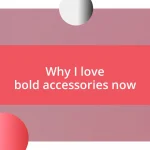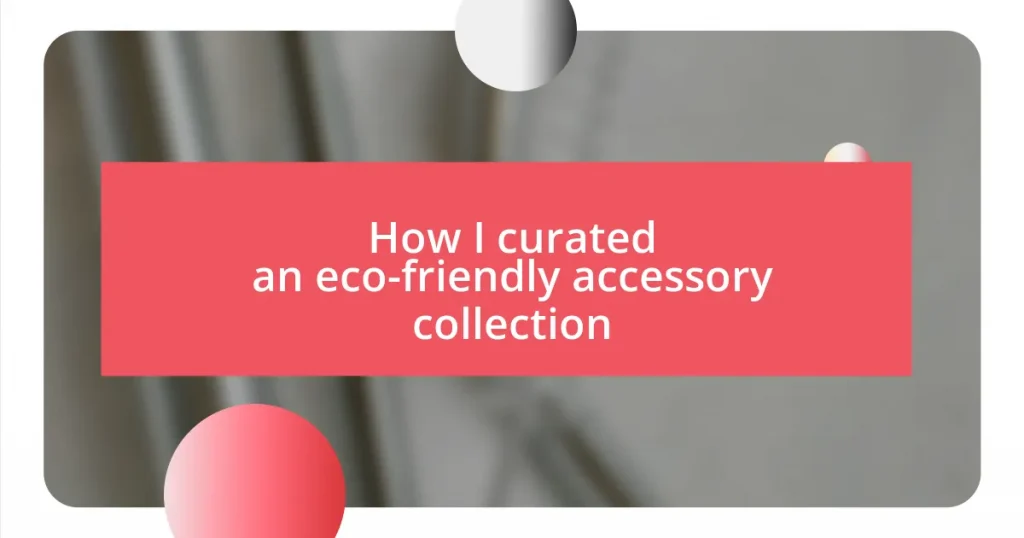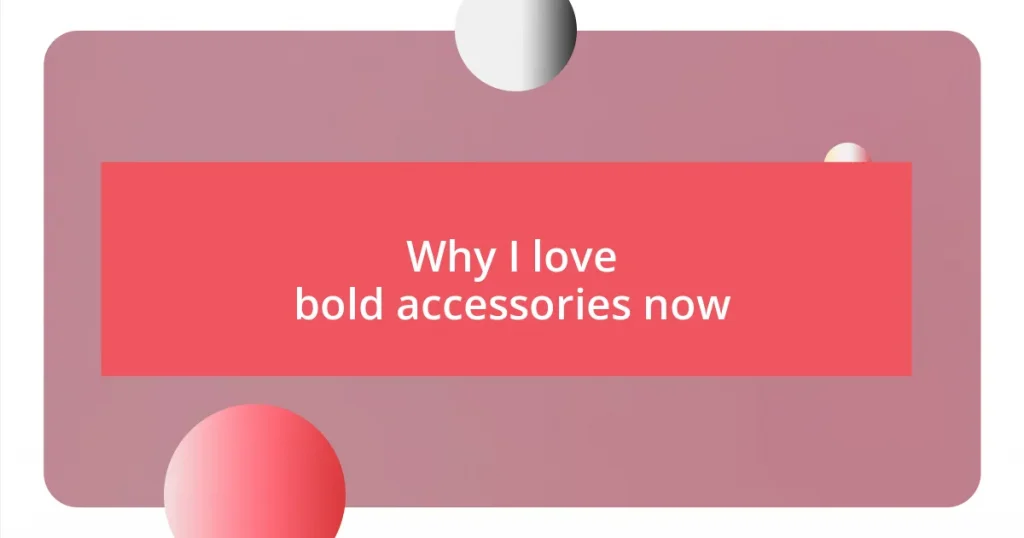Key takeaways:
- Eco-friendly accessories reflect a shift towards sustainability, emphasizing materials like recycled plastics and ethically sourced materials.
- Identifying sustainable materials involves looking for certifications (e.g., GOTS, Fair Trade) and understanding the life cycle and innovative options like vegan leather.
- Building relationships with reliable suppliers is crucial, focusing on ethical practices, transparency, and shared values in sustainability.
- Marketing involves storytelling, engaging with audiences, and highlighting the meaningful impacts of sustainable choices to foster community and brand loyalty.
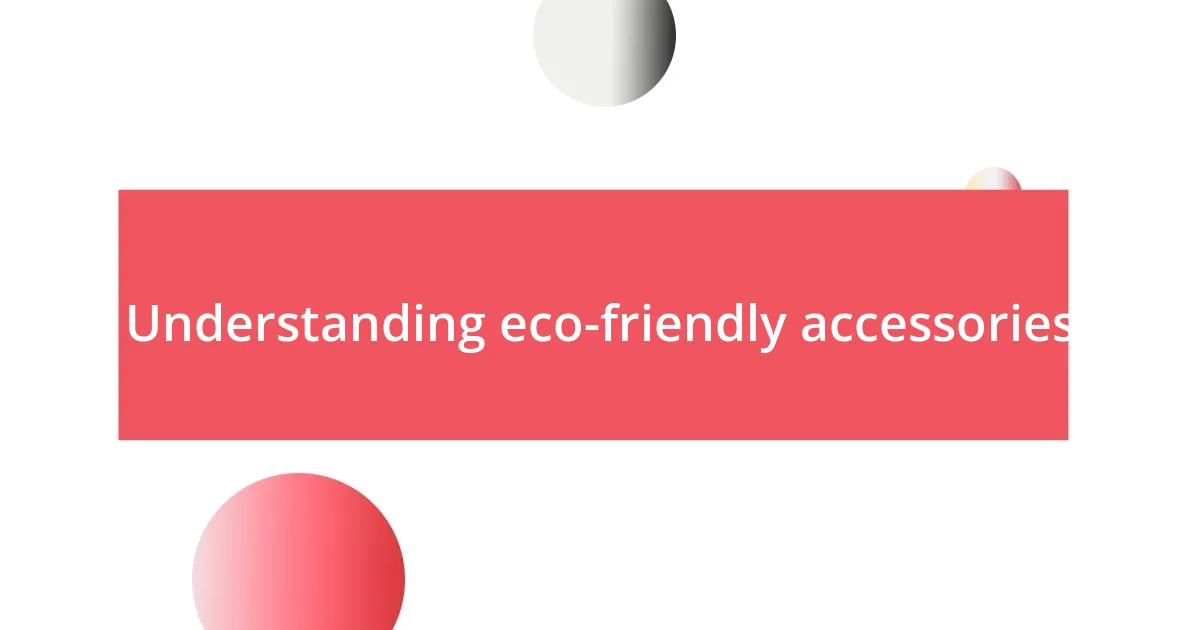
Understanding eco-friendly accessories
Eco-friendly accessories are not just trendy; they represent a mindset shift towards sustainability and environmental consciousness. When I first started exploring this world, I remember feeling a mix of excitement and confusion. It made me wonder—how can one piece of jewelry, a handbag, or even a watch make a difference? The answer lies in the materials and practices behind them.
Take, for instance, accessories made from recycled materials. I once stumbled upon a brand that crafted stunning earrings using repurposed ocean plastics. The story behind each piece was like a breath of fresh air, highlighting not just creativity but also a commitment to reducing waste. Every time I wore those earrings, I felt a connection to a larger purpose, which transformed an accessory into a conversation starter about sustainability.
Understanding eco-friendly accessories also means appreciating the craftsmanship and the ethos of the brands you support. Many small businesses prioritize ethical labor practices and eco-conscious materials, ensuring their products are kind to both people and the planet. Isn’t it satisfying to know that by choosing these accessories, you’re not just enhancing your style but also supporting a movement toward a better world?
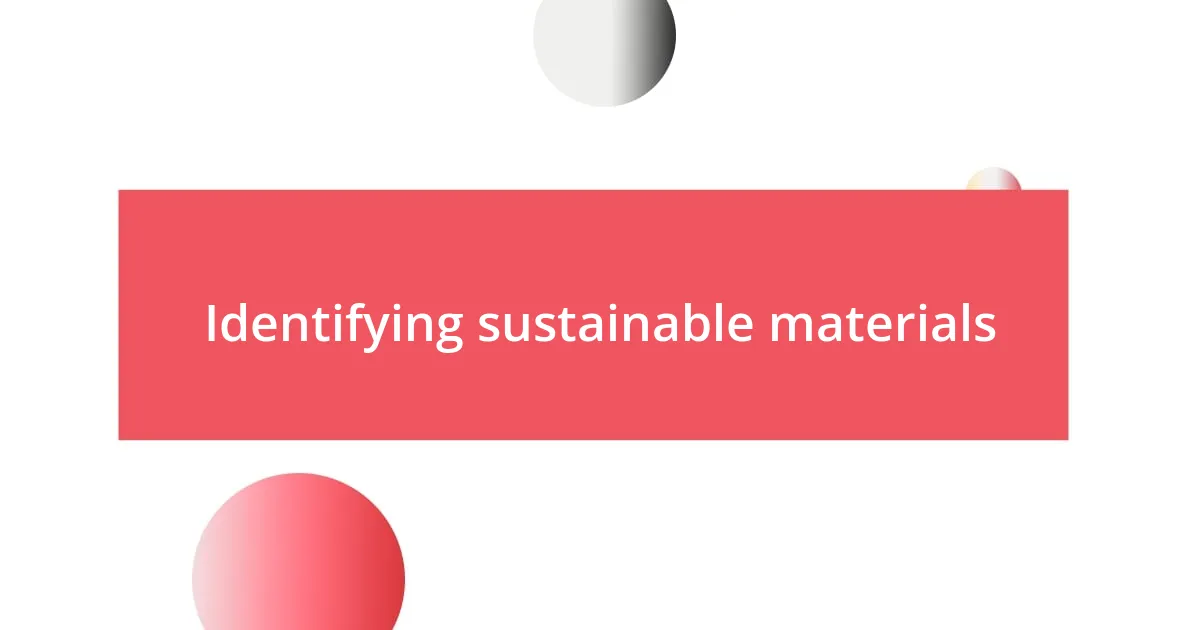
Identifying sustainable materials
Identifying sustainable materials can sometimes feel daunting, but it really comes down to a few key principles. In my journey, I’ve learned to look for certifications like Global Organic Textile Standard (GOTS) or Fair Trade labels. These markers not only ensure the materials are sustainable but also indicate fair labor practices—a critical factor for me. The first time I found a handbag made from organic cotton with a GOTS certification, I felt a surge of pride. It was like discovering a hidden gem that aligned perfectly with my eco-conscious values.
Another crucial aspect is understanding the life cycle of materials. I remember unearthing the beauty of Tencel, a fiber made from sustainably sourced wood pulp. Unlike conventional fabrics, Tencel is biodegradable and produced in a closed-loop process that minimizes waste. When I wore a dress made of Tencel to an event, I experienced such joy knowing that my choice was not just stylish but also gentler on our planet. That moment reinforced my belief that fashion can indeed be eco-friendly.
Lastly, don’t forget about innovative materials that emerge each day. For instance, vegan leather made from pineapples or mushrooms has gained traction and can be a fantastic alternative to traditional leather. I once attended a workshop showcasing how these materials are made, and it was fascinating. Seeing the potential was eye-opening! It made me realize that sustainable choices go far beyond recycling; they involve exploring new avenues that respect our Earth.
| Material | Sustainability Aspect |
|---|---|
| Recycled Materials | Reduces waste and encourages circular economy. |
| Organic Cotton (GOTS) | Eco-friendly farming and fair labor practices. |
| Tencel | Biodegradable and produced in a sustainable process. |
| Vegan Leather | Innovative alternatives to traditional leather without animal cruelty. |

Finding reliable suppliers
Finding reliable suppliers is a critical step in curating an eco-friendly accessory collection. During my search, I discovered that establishing genuine relationships with suppliers can make all the difference. I remember attending a local artisan market where I connected with a small business that produced accessories from upcycled materials. The passion and dedication in their eyes were contagious; it made me realize how vital it is to support those who share my values. Trust is built through transparency, so I always look for suppliers willing to share their sourcing and manufacturing processes.
Here are some key points to consider when searching for reliable suppliers:
- Ethical practices: Ensure that suppliers prioritize fair labor practices.
- Transparency: Choose partners who disclose their sourcing methods and material origins.
- Certifications: Look for recognized eco-labels to verify sustainability claims.
- Communicate: Engage in open conversations to understand their values and commitment to sustainability.
- Visit facilities: If possible, tour the production sites to see firsthand the care put into their practices.
Finding suppliers who truly align with your eco-friendly vision can be an enlightening experience. Each connection can transform your collection into a narrative of sustainability and community impact.

Designing unique accessory pieces
Creating unique accessory pieces requires a blend of creativity and intention. I often find inspiration in nature itself; for example, I once crafted a necklace using stones I collected during a hike. Each stone had its own story, and I felt a connection not just to the materials, but also to the environment where they originated. It’s moments like these that remind me of the beauty found in our surroundings and how it can be translated into wearable art.
When designing, I also prioritize functionality. I once made a bag that doubled as a reusable shopping tote. The reaction from friends was heartwarming—many mentioned how they’d love to have something that was not only stylish but also practical for their everyday lives. This experience showed me that unique designs should resonate with the user, balancing aesthetics with utility, which can often elevate an accessory from ordinary to extraordinary.
Moreover, the uniqueness of each accessory can stem from personal stories. My favorite bracelet features charms representing significant milestones in my life. Each charm sparks a memory, creating a conversation piece that’s not just about fashion; it’s about my journey. This personal touch allows others to connect, prompting questions like, “What does that charm represent?” I cherish those moments of sharing, as they turn an accessory into a meaningful keepsake. It’s these layers of connection and intent that I strive to embed in every piece I design.

Marketing your eco-friendly collection
Marketing your eco-friendly collection is not just about showcasing products; it’s about telling a story that resonates with your audience. I remember my first Instagram story where I shared the journey of creating my accessories. The response was heartwarming! People felt connected to the narrative behind the pieces, which made them more inclined to support the collection. This experience taught me that sharing your values can create a strong bond with customers.
Social media can be a powerful ally in promoting your eco-friendly collection, but it’s essential to use it strategically. For instance, I’ve found that engaging with followers through polls or Q&A sessions helps create a sense of community. After one such session where I asked what eco-friendly materials intrigued them the most, I noticed a surge in interest for sustainable leather alternatives. This direct feedback allows me to tailor my offerings in a way that feels personal and aligned with my audience’s desires.
Additionally, I prioritize collaborations with eco-conscious influencers. One memorable collaboration involved a local environmentalist who wore my pieces during a climate rally. The exposure was incredible, and it highlighted how fashion can advocate for a greater cause. This partnership not only expanded my reach but also solidified my brand’s commitment to sustainability. Connecting with like-minded individuals enriches the marketing experience, turning it into a shared mission rather than a sales pitch.
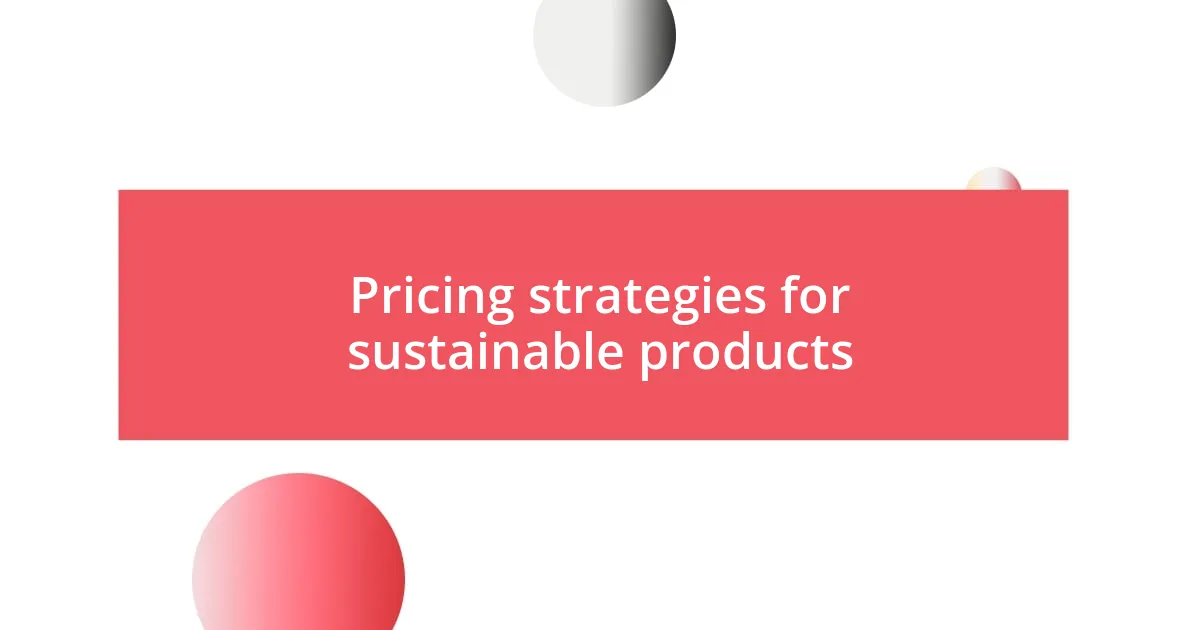
Pricing strategies for sustainable products
Pricing sustainable products involves a delicate balance between cost, value, and ethics. I remember grappling with how to set prices that not only covered my expenses but also reflected the care and sustainability embedded in each piece. It’s quite a challenge when you want to pay fair wages and use eco-friendly materials, yet still be approachable for shoppers—has anyone else faced this dilemma?
One effective strategy I’ve implemented is the “value-based pricing” model. Instead of competing on price alone, I focus on communicating the unique benefits of my accessories: the stories behind the materials, the artisans involved, and the environmental impact of each purchase. This approach has led to conversations that deepen customer appreciation for the product’s worth, making buyers more willing to invest in sustainable craftsmanship.
Additionally, I’ve found that offering tiered pricing options can attract a broader audience. For instance, I designed a limited edition line that came with a higher price tag but offered a unique story and exclusivity. This strategy not only enhances perceived value but allows me to provide more accessible options alongside it. It’s fascinating to see customers engage differently with various price points—sometimes, the allure of a meaningful, exclusive piece can transcend cost considerations altogether. Have you experienced shifts in customer behavior based on what you offer?
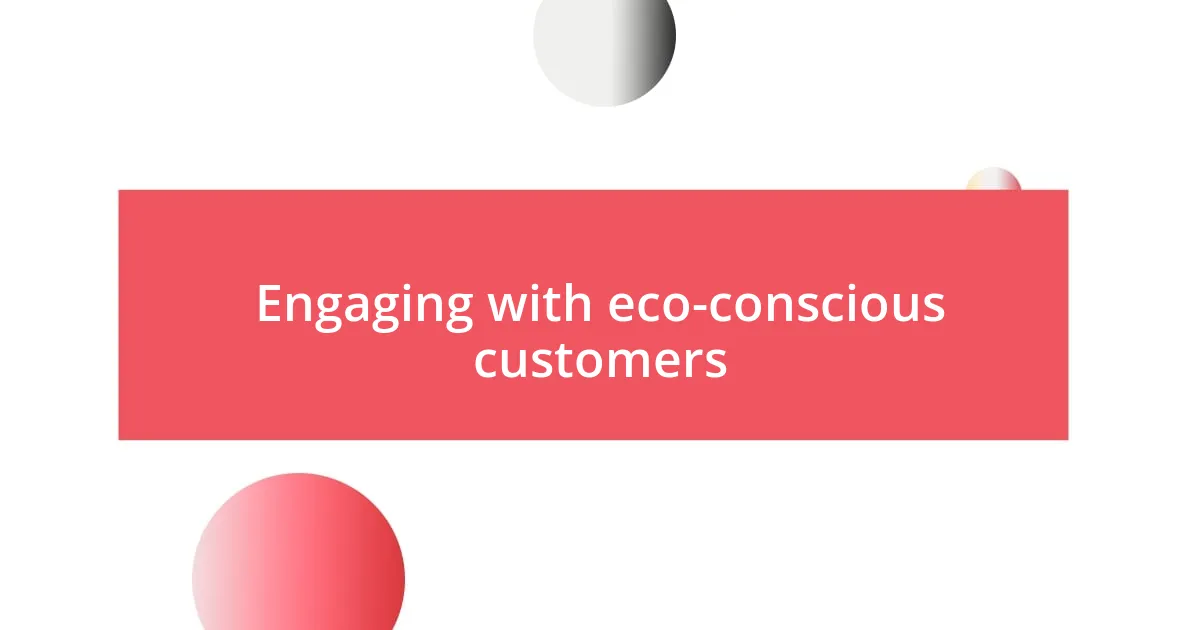
Engaging with eco-conscious customers
Understanding eco-conscious customers requires more than just knowing their preferences; it’s about connecting with their values. I distinctly remember hosting a pop-up shop where we discussed the impact of fast fashion. Some attendees shared their eco-journals, detailing their personal journeys toward sustainability. It was inspiring to see how sharing stories can transform a simple shopping experience into a meaningful conversation, reinforcing the bond between my brand and the customers.
I always strive to be transparent about my sourcing and production methods. I once featured a series of posts highlighting the artisans who create my accessories, detailing their craft and the sustainable materials they use. The response was overwhelming! Customers often appreciate knowing that their purchases directly support skilled craftspeople and the environment. This kind of transparency not only builds trust but also fosters loyalty—who wouldn’t want to support a brand that is as passionate about the planet as they are?
Using eco-conscious packaging also resonates well with customers. I recall the excitement I felt when launching my biodegradable packaging; sharing this decision with customers reinforced our commitment to sustainability. Engaging with them through feedback channels, like surveys, has repeatedly confirmed that they value these efforts. I wonder, how often do we consider the packaging as part of the product experience? Implementing such choices can deepen your connection with eco-aware customers, turning them into advocates for your brand.

